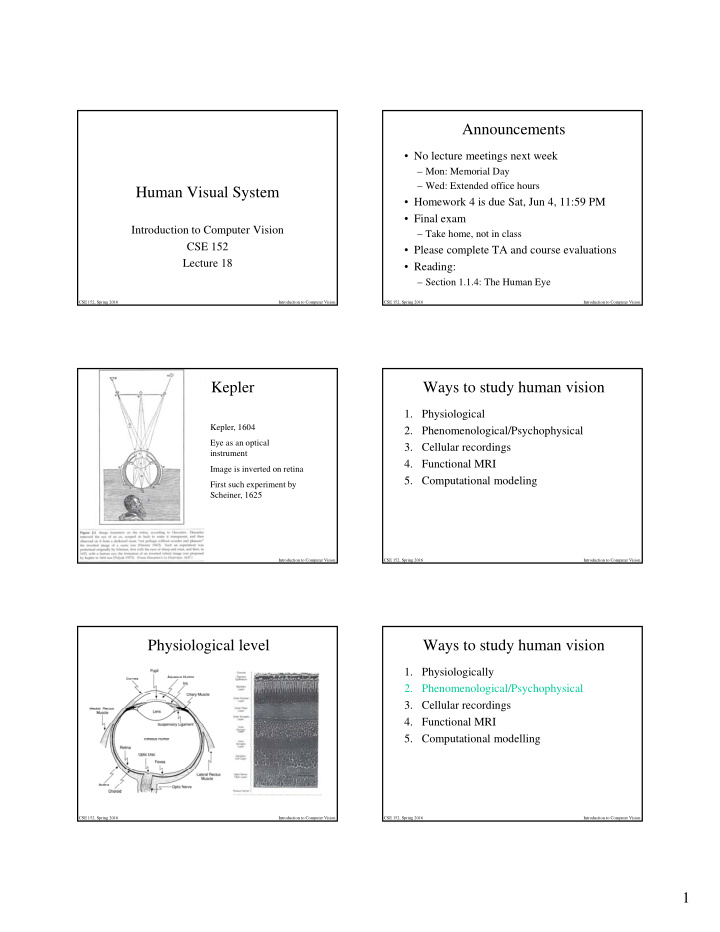



Announcements • No lecture meetings next week – Mon: Memorial Day – Wed: Extended office hours Human Visual System • Homework 4 is due Sat, Jun 4, 11:59 PM • Final exam Introduction to Computer Vision – Take home, not in class CSE 152 • Please complete TA and course evaluations Lecture 18 • Reading: – Section 1.1.4: The Human Eye CSE 152, Spring 2016 Introduction to Computer Vision CSE 152, Spring 2016 Introduction to Computer Vision Kepler Ways to study human vision 1. Physiological Kepler, 1604 2. Phenomenological/Psychophysical Eye as an optical 3. Cellular recordings instrument 4. Functional MRI Image is inverted on retina 5. Computational modeling First such experiment by Scheiner, 1625 CSE 152, Spring 2016 Introduction to Computer Vision CSE 152, Spring 2016 Introduction to Computer Vision Physiological level Ways to study human vision 1. Physiologically 2. Phenomenological/Psychophysical 3. Cellular recordings 4. Functional MRI 5. Computational modelling CSE 152, Spring 2016 Introduction to Computer Vision CSE 152, Spring 2016 Introduction to Computer Vision 1
Example: Psychophysical Testing of Subjects Show gratings with different spatial frequencies CSE 152, Spring 2016 Introduction to Computer Vision CSE 152, Spring 2016 Introduction to Computer Vision Gradients/Motion Perceptual Organization Look Here Occlusion provides a different organization CSE 152, Spring 2016 Introduction to Computer Vision CSE 152, Spring 2016 Introduction to Computer Vision Perceptual Organization Ways to study human vision 1. Physiologically 2. Phenomenological/Psychophysical 3. Cellular recordings 4. Functional MRI 5. Computational modeling CSE 152, Spring 2016 Introduction to Computer Vision CSE 152, Spring 2016 Introduction to Computer Vision 2
Single Cell Recordings fMRI Activation in the right fusiform gyrus. [ Tarr, Cheng 2003] CSE 152, Spring 2016 Introduction to Computer Vision CSE 152, Spring 2016 Introduction to Computer Vision Ways to study human vision Computational Modeling 1. Physiologically 2. Phenomenological/Psychophysical 3. Cellular recordings 4. Functional MRI 5. Computational modeling What is being computed and why? CSE 152, Spring 2016 Introduction to Computer Vision CSE 152, Spring 2016 Introduction to Computer Vision Structure of the eye 1 lux = 1 lumin/m 2 CSE 152, Spring 2016 Introduction to Computer Vision CSE 152, Spring 2016 Introduction to Computer Vision 3
Rods and cones Rods and cones Cones CSE 152, Spring 2016 Introduction to Computer Vision CSE 152, Spring 2016 Introduction to Computer Vision Distribution of Rods & Cones Three types of cones: R,G,B ( ) E ( ) d Response of k th cone = k There are three types of cones S: Short wave lengths (Blue) • Three attributes to a color M: Mid wave lengths (Green) • Three numbers to describe a color L: Long wave lengths (Red) CSE 152, Spring 2016 Introduction to Computer Vision CSE 152, Spring 2016 Introduction to Computer Vision Retina edge on Retinal Neuron Bipolar Cell Ganglion CSE 152, Spring 2016 Introduction to Computer Vision CSE 152, Spring 2016 Introduction to Computer Vision 4
Visual Pathways Where: What: Location & Recognition, Motion, control Object representation CSE 152, Spring 2016 Introduction to Computer Vision CSE 152, Spring 2016 Introduction to Computer Vision Trilobite Visual System • Most ancient known visual system. • Compound eye with single crystal for each lens. Other Eyes Electron Micrograph of Holochroal eye Good trilobite eye info at: http://www.aloha.net/~smgon/eyes.htm CSE 152, Spring 2016 Introduction to Computer Vision CSE 152, Spring 2016 Introduction to Computer Vision Stomatopod eyes Scallop eyes • Dumb bell shaped, compound eyes (next slide) • Hundreds of primitives eyes, mirror in back • Stereo vision with just one eye; • Changes in light and motion and very rough images are • Each eye is up on a stalk, with a wide range of motion; registered on the retinas of the mollusk. • Stomatopods have up to 16 visual pigments • Nice material at: http://soma.npa.uiuc.edu/courses/bio303/Ch11b.html – stomatopods can see ultra-violet and infra-red light – some can see polarized light • See http://www.ucmp.berkeley.edu/aquarius/ Larva Mantis Shrimp Adult Mantis Shrimp CSE 152, Spring 2016 Introduction to Computer Vision CSE 152, Spring 2016 Introduction to Computer Vision 5
Mantis Shrimp Cues Trinocular vision CSE 152, Spring 2016 Introduction to Computer Vision CSE 152, Spring 2016 Introduction to Computer Vision Fixate at center Shading Cues What color are the dots? CSE 152, Spring 2016 Introduction to Computer Vision CSE 152, Spring 2016 Introduction to Computer Vision Subjective Contours Which square is darker? Kanizsa’s Triangle CSE 152, Spring 2016 Introduction to Computer Vision CSE 152, Spring 2016 Introduction to Computer Vision 6
Global vs. Local information: Which square is darker? Fraser’s Spiral CSE 152, Spring 2016 Introduction to Computer Vision CSE 152, Spring 2016 Introduction to Computer Vision CSE 152, Spring 2016 Introduction to Computer Vision CSE 152, Spring 2016 Introduction to Computer Vision Context Context: Whose faces do you see? Who is taller? Who is taller? CSE 152, Spring 2016 Introduction to Computer Vision CSE 152, Spring 2016 Introduction to Computer Vision 7
A picture of a man In this shot, what is his facial expression? CSE 152, Spring 2016 Introduction to Computer Vision CSE 152, Spring 2016 Introduction to Computer Vision In this shot, what is his facial expression? Hidden Human Face Thatcher illusion CSE 152, Spring 2016 Introduction to Computer Vision CSE 152, Spring 2016 Introduction to Computer Vision Horizontal Lines are Parallel Static Image CSE 152, Spring 2016 Introduction to Computer Vision CSE 152, Spring 2016 Introduction to Computer Vision 8
Summary of CSE 152 • Geometric image • Structure from motion formation • Model fitting • Photometric image • Optical flow and formation motion • Photometric stereo • Tracking • Binary image • Recognition, processing detection, and • Filtering classification • Edges and corners • Color • Stereo • Human visual system CSE 152, Spring 2016 Introduction to Computer Vision 9
Recommend
More recommend